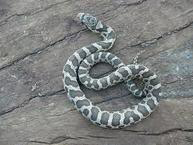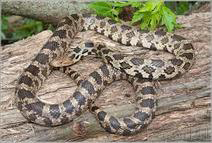Erica Mede, CVT
Description
 Western Fox snakes are shy snakes reaching lengths of 3-5 feet. Males are typically larger than females. With a life span of 10-12 years, these rather sluggish snakes not the most common snake kept in captivity. Adults are yellow to dark brown with red-brown blotches along the back. The belly scales are yellow with black marks but the head of adults remain bronze and unpatterned. Adults also have rings around their short tails. Hatchlings are about 8-12 inches long and their head has a distinct black line going from the eye to the jaw and across the head between the eyes. Fox snake hatchlings typically have grayish coloration with blackish blotches along the back.
Western Fox snakes are shy snakes reaching lengths of 3-5 feet. Males are typically larger than females. With a life span of 10-12 years, these rather sluggish snakes not the most common snake kept in captivity. Adults are yellow to dark brown with red-brown blotches along the back. The belly scales are yellow with black marks but the head of adults remain bronze and unpatterned. Adults also have rings around their short tails. Hatchlings are about 8-12 inches long and their head has a distinct black line going from the eye to the jaw and across the head between the eyes. Fox snake hatchlings typically have grayish coloration with blackish blotches along the back.
Western Fox snakes are a hardy species and are both diurnal and terrestrial, sporting the classic round pupils that most people associate with “safe” snakes. This species is frequently mistaken for Pine snakes and occasionally young Bull snakes. A very unfortunate confusion occurs between adult Fox snakes and Massasauga rattlesnakes. When startled, these snakes will often mimic rattling by vibrating their tail quickly and when all else fails, musk their captors with a fluid that smells curiously like fox musk.
Natural History
These diurnal snakes are found throughout the western and central United Statesespecially in western Michigan , Wisconsin , Minnesota , Illinois , Iowa , and South Dakota black soil prairies. This species of snake does hibernate during the winter months.
Enclosure
Adults are easily kept in a 20-30 gallon glass aquarium with a screen lid. The larger the cage and the wider the cage the better! Wider enclosures allow for more exercise and fulfill this species urge to explore. Custom designed enclosures can be created but aren’t commonly utilized in the pet industry. However, custom enclosures created with a little ingenuity and imagination can offer supreme naturalistic set-ups. Hatchlings can be kept in 10 gallon aquariums.
Substrate
Substrate should be easy to clean and dry. Newspaper, reptile carpet, and paper towel are favorites for hatchlings and new individuals to help monitor fecal output. Most established individuals can be maintained happily on the above or aspen shavings as long as it is agitated frequently and changed every 7-14 days. Never use pine or cedar shavings which have aromatic oils that can cause irritation and respiratory issues in snakes. Enrichment can be provided by placing hay, straw, or even dried leaves in the cage for the snake to explore and navigate through.
 Western Fox snakes require an ambient temperature of 80-85°F which is easily provided with under tank heaters, heat tape, heat cable (on the outside of the cage not the inside). The temperatures can be controlled easily with a thermostat and monitored with the use of three thermometers. One thermometer placed on the warm end an inch above the substrate, one placed at the level of the basking site, and another placed an inch above the substrate on the cooler end. A basking site should be 85-88°F. At night, the temperature can drop as low as 75°F.
Western Fox snakes require an ambient temperature of 80-85°F which is easily provided with under tank heaters, heat tape, heat cable (on the outside of the cage not the inside). The temperatures can be controlled easily with a thermostat and monitored with the use of three thermometers. One thermometer placed on the warm end an inch above the substrate, one placed at the level of the basking site, and another placed an inch above the substrate on the cooler end. A basking site should be 85-88°F. At night, the temperature can drop as low as 75°F.
Humidity should be moderate, 35-60%, with the higher end utilized during shedding. Humidity can be monitored with a hygrometer and increased with the use of a large water bowl, fogger, mister, or daily spraying.
Accessories
Branches for climbing should be offered to Fox snakes for exercise and increased basking areas. Fox snakes will climb low branches but are not excellent climbers. Natural and fake foliage can be placed in the cage to increase hiding locations. Hide boxes in the form of half logs, PVC pipes, and half flower pots can be utilized. Rocks can be added especially for basking areas if they are placed over a heat source and under the basking light to warm the rock. A large water bowl is highly recommended to allow the snake to soak at will.
Reproduction
Mating season for Fox snakes begins in late spring and early summer. Successful mating will result in the female laying eggs two months after. Rat snakes lay 15-20 eggs. Hatchlings are tiny, generally 8-12 inches long and emerge in late August to early October (about 65-70 days after eggs are laid).
Feeding
In the wild, these snakes feed primarily on rodents such as mice and voles. In captivity, these snakes are fed primarily mice. It is recommended that only pre-killed prey be offered as live prey has the potential of severely injuring or killing captive snakes, especially those unaccustomed to live prey. Chicago Exotics recommends feeding properly thawed frozen rodents. Hatchlings can be fed every 5-7 days. Juveniles should be offered food every 7-10 days and adults fed every 10-14 days.
Sources and Recommended Reading
The New Encyclopedia of Snakes, Christopher Mattison
Living Snakes of the World, John M. Merirtens
Good Snakekeeping, Philip Purser
If you have any questions, please feel free to call us at (502) 241-4117.

